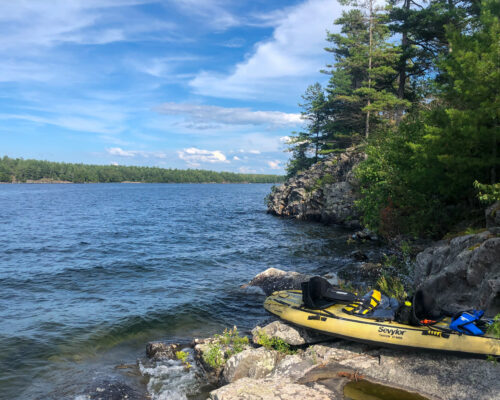Planning a backcountry trip can take a lot of coordination, there are many details that need to be considered. This is how I plan a backcountry trip to Ontario Parks or National Parks that allow reservations ahead of time.
Transportation
You need to make sure you consider transportation to your backcountry access point. Many people drive to their backcountry access points but there are also sometimes busses available from nearby cities. It’s important to research what is available.
Some sites are on islands. For these sites you may need to reserve a spot on a shuttle depending on what is included in your site. Keep in mind that some shuttles don’t allow dogs or have other limitations. Look up what the rules of the shuttles are. There are oftentimes water taxis available from nearby marinas as well. Make sure you call and book them well in advance, they often fill up when the campgrounds fill up.
You may also rely on a canoe or kayak to get to your site. If you are planning to rent one, many campgrounds offer rentals. Make sure you call ahead as they can go quickly and make sure you have the required safety equipment like a whistle and PFD.
Route
When planning a backcountry trip you need to plan out your route. You can find the distances for some routes online but I prefer to look at a map so I can evaluate the distance, changes in elevation, proximity to a water source and see my full route for the trip. I also use this map on the trip to navigate. It’s important to take your hiking experience and abilities into account and to remember that you will need to carry all of your supplies so you may not be able to hike as long as you would with less weight in your backpack. I normally look at the distances between sites and pick the site that works best for the route I want to complete.
People
When planning a trip it’s important to know how many people are going. The reservation system may ask how many people are going and request their names. You also need to make sure you plan for the skills of everyone in the group and have equipment for everyone. Most sites I have booked for have a capacity for 6 – 9 people per site.
Dates
For backcountry camping I normally try to complete a specific route and move to a different site every night. For this you normally need to book a spot on a specific site or area to ensure you have a spot and permit. You normally need to book on a certain date for a certain time. Try looking up the booking process for where you are planning to stay to make sure you get all relevant information before booking starts.
Reservations
A lot of times it can be hard to get reservations for the more popular times of the year in the more popular campgrounds. Make sure you know the sites and route you are planning before the reservation day and ensure the sites you are looking at are available. Most sites I have booked offer online bookings or the ability to call in to reserve sites. I normally find it quicker and easier to reserve a site online if it’s an option.
After all of this I would move on to packing for the trip closer to the departure date. These are just some of the things I take into account when first planning and reserving a trip before the actual trip.I hope these tips help you and I would love to hear if there is anything different anyone else does!



